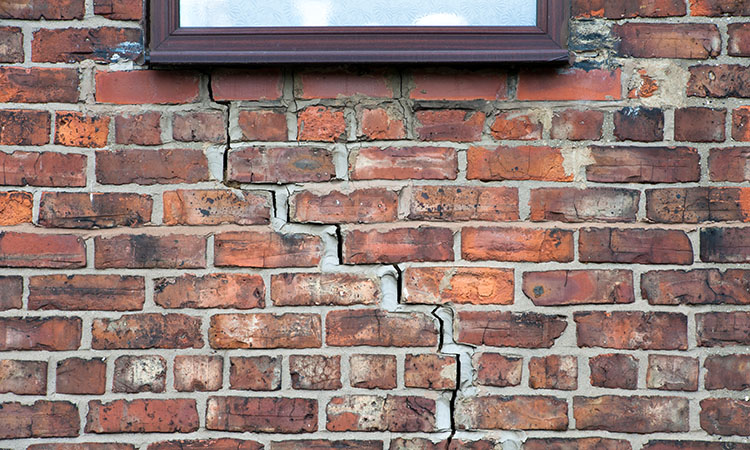Last Updated on June 1, 2023
Your home is the foundation upon which you build the life you want. So, what do you do if you’re sitting on a bad foundation?
This question is more than metaphorical. A home’s foundation is very literally what holds it up and what holds it together. And like metaphorical foundations, sometimes by the time you notice problems, it’s too late to make easy repairs.
So, how can you tell if your home has a bad foundation?
Luckily, there are a number of physical signs to look for when examining the concrete slab, pier, or beam foundation of a house. Here are the most serious and less serious stressors to look for in a home’s foundation.
Serious signs of a bad home foundation
Home foundation deterioration can be caused by a variety of things. These include climate, poor soil compaction, plumbing leaks, and inadequate drainage. Bad foundations present themselves as deterioration of stem walls or either foundation settlement or foundation heave. And while age can play a factor, it’s possible to see these issues in brand new homes, too.
Take immediate action if you spot any of the following.
Exterior Stair-step Cracks – Examine bricks for tell-tale stair-step cracks in the mortar of your brickwork. Check closely around windows, especially. The direction of the crack indicates the direction of settlement that’s strong enough to be a foundation issue.
Interior Diagonal Cracks – Similarly, look out for diagonal drywall/sheetrock cracks creeping out from the corners of door and window frames. Experts say this means settlement forces are pulling down or pushing up on a portion of the wall and cracking the wallboard. Doors or windows pulling away from the wall is another silent sign.
Exterior Gapping or Separation – Check the alignment of long horizontal wood trim along brick friezes or other features of your home’s exterior. If the trim is pulling away from the home, that is a sign of brick or exterior wall movement. Warped siding can also indicate structural problems from moisture issues.
Interior Movement of Wood Trim, Built-Ins, and Fixtures – Look at the built-in bookshelves and kitchen and bathroom cabinetry. These should not be pulling away from the walls. If they are, it could indicate settling. Similarly, new gaps between tile backsplashes and counters indicate walls or floors moving.
Doors Becoming Misaligned – Wooden doors and frames swell and contract with changes in weather. But if you’re noticing that a door frame has been pulled “out of square,” it could be due to movement in the foundation. Look for doors sticking or not latching properly.
Possible (but maybe not) signs of a bad home foundation
Buildings live and breathe. And with that comes some minor settling over time, as well as normal wear and tear. Consider them your home’s “wrinkles.”
The signs listed below could be signals of age or aging workmanship. But by themselves, they don’t always point to foundation issues. However, if you’re seeing many of these in combination with the signs above, go ahead and contact your contractor.
Seam Breaks and Ceiling Cracks – Poor workmanship ages even more poorly. This is especially noticeable at the seams of interior walls and ceiling sheetrock. Straight vertical or horizontal patterns of flaking or cracking, especially near studs or edges, do not necessarily signal foundation issues.
Nail Pops – Circular nail pop bumps along your studs or on edges are a common source of stress in homeowners. But they don’t necessarily signal stress to your foundation. If you notice a lot of them—or repeat pops after repairs—in conjunction with other issues, then you can worry.
Cracks above the Garage – Cracks, even stair-step cracks, coming from the top of your garage door most often have a different source than a settling foundation. Instead, the support angle iron (brick lintel) over the garage door could be compromised. You should address these, but as a separate matter.
Hairline Cracks and Flaws in Concrete – Hairline cracks and cosmetic flaws are normal in the setting and wear and tear of concrete. These can include flaking, spalling, or honeycombing of concrete floors or other exposed concrete surfaces. Beware excessive gaps or changes in leveling.
Cracks in Tilework and Grout – The larger the expanse of tile, the more likely that you’ll notice some natural cracking over time. Be cautious of bouncing floors underneath, which could indicate rotten wood, or excessive vertical cracking—these need to be addressed.
What to do if you think your home has a bad foundation
Your home inspector is the first canary to sound the alarm about a bad foundation. However, home inspectors are only trained to see the basic signs of structural damage. An experienced foundation repair contractor can take a closer look at your foundation or basement, and then pinpoint the source of the problem. In some instances, you may also need to enlist a structural engineer to evaluate the situation and prepare a formal engineer’s report.
If this sounds like a lot of work—and a lot of money—it can be. Foundation repairs average around $3,500, according to HomeAdvisor.com. Brand new foundations can cost up to $40,000.
Ultimately, any sort of structural issue should be addressed as quickly as possible. And while there are always ways to make repairs more affordable, this is one area where you don’t want to cut corners on quality.
After all, you can’t build a strong foundation in life without a strong foundation under your feet.
All real estate is local. In order to make confident real estate decisions, it’s important to have timely and neighborhood-specific information. Contact us today to speak with an Allen Tate/Beverly-Hanks real estate agent about buying homes and land in Western North Carolina.





This really provides a valuable checklist for homeowners to identify potential foundation issues. The breakdown of warning signs like cracks, uneven floors, and sticking doors is particularly useful for early detection.
It also mentions contacting a professional for a thorough inspection if any of these signs are present. For homeowners who might be concerned about a minor crack, are there any basic tests they can perform themselves before calling a professional?